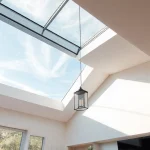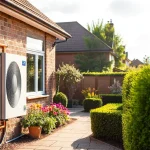Smart Solutions for Improving Air Circulation in UK Homes with Restricted Ventilation
Understanding the Importance of Ventilation in UK Homes
When it comes to maintaining a comfortable and healthy living environment, ventilation is often an overlooked but crucial aspect. In the UK, where homes are increasingly being retrofitted to be more energy-efficient and airtight, ensuring proper ventilation is more important than ever. Without it, homes can suffer from damp, mould, and poor indoor air quality, undermining the very benefits of energy-efficient upgrades.
“Before sealing up a home, understand how it currently ‘breathes.’ A good retrofit plan accounts for what’s already there and includes solutions to replace natural airflow with something more controlled,” advises Michael Zohouri of The Retrofitters[1].
Additional reading : Maximizing energy savings: essential tips for effortlessly combining solar panels with home battery storage in the uk
Mechanical Ventilation with Heat Recovery (MVHR) Systems
One of the most effective solutions for improving air circulation in homes with restricted ventilation is the installation of Mechanical Ventilation with Heat Recovery (MVHR) systems. These systems are designed to extract stale air while recovering the heat, which is then used to warm incoming fresh air.
Benefits of MVHR Systems
- Energy Efficiency: MVHR systems provide consistent fresh air while retaining heat, reducing energy waste and lowering energy consumption[1][5].
- Improved Indoor Air Quality: They filter out allergens, dust, and pollutants, significantly improving indoor air quality[1][5].
- Compatibility with Airtight Homes: MVHR systems work seamlessly with airtight homes, ensuring healthy airflow without compromising efficiency[1].
Installation Best Practices
To get the most out of MVHR systems, it’s essential to position the units in central areas like hallways or utility rooms to minimize ducting distances. Insulating the ducts prevents heat loss and ensures the system runs quietly[1].
Also to read : Transform your space with modern steel doors
Localised Ventilation Solutions
Not every home requires a full MVHR system, especially for smaller projects or where budget constraints exist. Localised ventilation solutions can be just as effective.
Targeted Ventilation
- Extractor Fans: Modern extractor fans, especially those compliant with Energy-Related Products (ERP) standards, are more energy-efficient and can be equipped with humidity sensors or timers. These fans are ideal for areas like kitchens and bathrooms where moisture and pollutants accumulate[1].
- Cooker Hoods: For retrofitted kitchens, consider cooker hoods that extract air externally rather than recirculating it, which helps in maintaining better air quality[1].
Ensuring a Balanced Approach to Ventilation
Ventilation is about balance. While removing stale air is essential, too much ventilation can lead to heat loss, undermining the energy savings achieved through retrofitting.
Calculating the Right Ventilation Rate
The key is calculating the right ventilation rate for the home, which depends on factors such as the size of the property, the number of occupants, and the level of insulation. “Every home is different. A one-size-fits-all approach doesn’t work with ventilation. It’s about understanding the property and tailoring solutions to ensure it’s both efficient and comfortable,” explains Michael Zohouri[1].
Common Pitfalls to Avoid in Ventilation
When retrofitting a home, there are several common pitfalls related to ventilation that should be avoided.
Skipping Ventilation During Insulation Upgrades
Retrofitting without considering ventilation can lead to damp, mould, and poor air quality. Always include ventilation in the retrofit plan[1].
Installing Poorly Designed Systems
Incorrectly sized or poorly installed ventilation systems can be noisy, inefficient, and fail to maintain air quality. Working with experienced professionals is crucial to avoid costly mistakes[1].
Neglecting Maintenance
Even the best ventilation systems need regular upkeep. Filters should be cleaned or replaced, and ducts checked for blockages to keep the system running efficiently[1].
Compliance with Building Regulations
In the UK, building regulations, specifically Part F of the Building Regulations, set out standards for ventilation in all homes, including retrofitted properties.
Key Requirements
- Minimum Airflow Rates: Standards for minimum airflow rates for different types of spaces.
- Mechanical Ventilation Systems: Requirements for noise levels and energy efficiency.
- Guidelines for Air Quality: Guidelines to maintain air quality in highly insulated homes[1].
Meeting these regulations not only avoids legal issues but also ensures better results for homeowners, creating safer and healthier living spaces.
The Role of Construction Professionals
Construction professionals play a vital role in ensuring that ventilation is done right. Here are some ways they can contribute:
Integrating Energy-Efficient Solutions
Construction professionals can integrate energy-efficient solutions like MVHR systems into the retrofit process[1].
Balancing Airtightness and Ventilation
They must strike the right balance between airtightness and ventilation to ensure efficient and healthy airflow[1].
Educating Homeowners
Educating homeowners on the importance of ventilation and how to maintain their systems is crucial for long-term efficiency and comfort[1].
“Good ventilation doesn’t just happen — it’s planned. By taking a proactive approach, we can create homes that are energy-efficient, healthier, and more comfortable for the people living in them,” emphasizes Michael Zohouri[1].
Smart Home Technologies for Enhanced Ventilation
Smart home technologies can significantly enhance ventilation solutions, making them more efficient and responsive to the needs of the home.
Advanced Sensors and Controls
Smart thermostats and sensors can provide real-time data about temperature, humidity, and occupancy, helping to optimize ventilation settings. For example, Switchee’s smart thermostats not only control heating but also provide actionable insights to residents on how to reduce energy costs and improve comfort[3].
Data Analytics and Performance Measurement
Algorithms like SmartHTC can integrate with smart thermostats and IoT platforms to present risk scores for mould, condensation, and overheating concerns in individual rooms. This data can help homeowners and retrofit assessors identify key interventions to improve the thermal performance of the building[3].
Practical Insights and Actionable Advice
Here are some practical tips and advice for improving air circulation in your home:
Assess Your Home’s Current Ventilation
Before any retrofit, understand how your home currently breathes. Identify areas prone to poor airflow, such as basements, bathrooms, and kitchens.
Choose the Right Ventilation System
- MVHR Systems: Ideal for whole-house ventilation, especially in airtight homes.
- Localised Solutions: Extractor fans and cooker hoods for targeted ventilation in specific areas.
Maintain Your Ventilation System
Regular maintenance is key. Clean or replace filters, and check ducts for blockages to ensure the system runs efficiently.
Consider Smart Home Integration
Integrate smart sensors and controls to optimize your ventilation system’s performance and energy efficiency.
Comparative Table: Ventilation Solutions
| Ventilation Solution | Description | Benefits | Suitable For |
|---|---|---|---|
| MVHR Systems | Mechanical Ventilation with Heat Recovery | Energy-efficient, improves indoor air quality, compatible with airtight homes | Whole-house ventilation, especially in airtight homes |
| Extractor Fans | Localised ventilation for specific areas | Energy-efficient, ERP compliant, equipped with humidity sensors or timers | Kitchens, bathrooms, and other moisture-prone areas |
| Cooker Hoods | External air extraction for kitchens | Reduces moisture and pollutants, improves air quality | Retrofitted kitchens |
| Single Room Heat Recovery Units | Decentralised supply and extract fans | Improves air quality, reduces condensation and mould | Single rooms or smaller spaces[4] |
| Positive Input Ventilation (PIV) Units | Loft-mounted units providing positive input ventilation | Improves air quality, reduces condensation | Homes with loft spaces[4] |
Improving air circulation in UK homes with restricted ventilation is not just a technical necessity but a key to creating healthier, more comfortable, and energy-efficient living spaces. By understanding the importance of ventilation, choosing the right systems, and integrating smart home technologies, homeowners can ensure their homes breathe well and maintain excellent indoor air quality.
“Ventilation is a crucial yet often overlooked part of retrofitting. Without it, the advantages of insulation and airtightness can be ruined by problems like damp, mould, and poor air quality. Using smart ventilation strategies helps make retrofitted homes healthier, more comfortable, and as energy-efficient as planned,” concludes Michael Zohouri[1].
By taking a thoughtful and balanced approach to ventilation, we can create homes that not only meet technical standards but also provide a pleasant and healthy living environment for their occupants.










